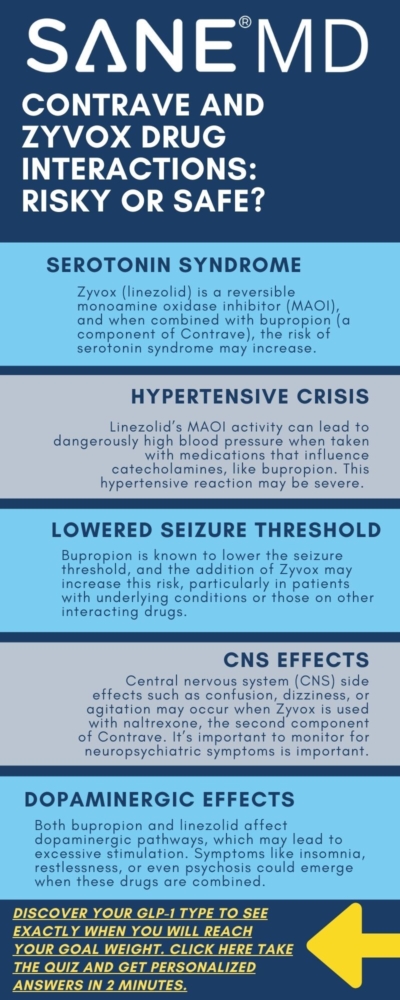Contrave and Zyvox Drug Interactions: Harmful Combo or Safe?
Dr. Matthew Olesiak, MD, is the Chief Medical Director at SANESolution, a renowned wellness technology company dedicated to providing evidence-based solutions for optimal living. Dr. Olesiak earned his medical degree from the prestigious Jagiellonian University Medical College in Kraków, Poland, where he developed a strong foundation in medicine.

When it comes to managing both physical and mental health conditions, combining medications is often necessary—but not without risk. One such potentially risky combination involves Contrave, a popular weight loss aid, and Zyvox (generic name: linezolid), a monoamine oxidase inhibitor (MAOI) used to treat bacterial infections. Patients considering taking Contrave while on Zyvox or vice versa need to be aware of the potential for serious side effects, particularly due to their overlapping impact on neurotransmitters.
Both drugs serve critical functions in modern medicine. Contrave, a combination of naltrexone hydrochloride and bupropion hydrochloride, is FDA-approved for weight management in certain adults with a body mass index (BMI) over 30, or over 27 with other health risks like high blood pressure. Zyvox, on the other hand, is reserved for serious infections, especially those resistant to other antibiotics.
But are Contrave and Zyvox drug interactions dangerous—or manageable under proper supervision? This article explores the risks, mechanisms, and safe usage guidelines, supported by expert insights from Dr. Matthew Olesiak, MD, Chief Medical Director at SANE MD.
Key Takeaways
- Combining Contrave and Zyvox can result in life-threatening interactions, including serotonin syndrome and an increased risk of seizures.
- Always tell your doctor about any other medications, especially monoamine oxidase inhibitors like Zyvox, before starting treatment with Contrave.
- Due to its effect on neurotransmitters, Zyvox is not typically recommended alongside drugs like Contrave, which contain bupropion hydrochloride.
Understanding Contrave’s Active Ingredients
Contrave combines two active ingredients: naltrexone hydrochloride, commonly used in opioid dependence treatments, and bupropion hydrochloride, also known as Wellbutrin SR or Wellbutrin XL, which is used to treat depression and aid in smoking cessation.
Bupropion is known for its unique pharmacology, acting as a norepinephrine-dopamine reuptake inhibitor (NDRI). Unfortunately, this also makes it a drug that carries an elevated risk of seizures, particularly in those with a history of seizure disorder, eating disorders like anorexia nervosa, or who use higher doses.
The Food and Drug Administration (FDA) emphasizes caution when prescribing medications that increase seizure susceptibility, particularly when combined with other agents that also alter neurotransmitter levels.
“When combining medications like Contrave with others that act on serotonin or dopamine systems, the potential for adverse interactions increases significantly,” explains Dr. Matthew Olesiak, MD. “This is especially true when considering MAOIs like Zyvox.”
Zyvox: A Monoamine Oxidase Inhibitor (MAOI)
Zyvox (linezolid) belongs to a rare class of antibiotics—monoamine oxidase inhibitors. Although used primarily to fight infections, it can also inhibit monoamine oxidase in the brain, the same mechanism targeted by certain antidepressant medications.
This makes Zyvox particularly problematic when taken with drugs like Contrave. Combining two agents that both influence neurotransmitters can increase the risk of serotonin syndrome, a potentially life-threatening condition marked by agitation, confusion, irregular heartbeat, trouble breathing, and muscle rigidity.
Zyvox also appears in contraindication lists for many medications—including bupropion-based drugs. In fact, MAOIs like isocarboxazid, marplan, linezolid, and zyvox are contraindicated with bupropion due to the risk of hypertensive crisis and seizure risk.
“It’s essential to tell your doctor if you’re on Zyvox or have taken any MAOIs in the past 14 days before starting treatment with Contrave,” says Dr. Olesiak. “This combination is one we typically avoid unless absolutely necessary and closely monitored.”
The Role of Contrave in Weight Management
Contrave plays an important role in modern weight management, particularly for adults who struggle to achieve meaningful results through lifestyle changes alone. It is mainly prescribed as part of a weight loss program that involves a reduced-calorie diet and regular exercise.
Its unique combination of naltrexone hydrochloride and bupropion hydrochloride makes it one of the few FDA-approved medications designed to support long-term behavioral change around eating and exercise.
As a weight loss aid, Contrave works on two major pathways in the brain: the hunger and reward systems. Bupropion stimulates dopamine and norepinephrine activity, reducing food cravings and enhancing motivation, while naltrexone blocks certain opioid receptors linked to pleasure-driven eating. Together, these active ingredients help suppress appetite and curb the emotional drive to overeat for compatible patients—especially in response to stress or habit.
Patients frequently ask how much weight they can expect to lose while taking Contrave. Although individual results depend on diet adherence, physical activity, and overall health, clinical studies have shown that patients using Contrave alongside a reduced-calorie diet achieved greater weight loss than those using diet and exercise alone.
According to a clinical trial published in the Journal of Clinical Obesity, patients treated with naltrexone-bupropion (Contrave) experienced an average weight loss of approximately 5% to 10% of their starting body weight over the course of one year. This weight reduction was accompanied by improvements in body mass index and other obesity-related risk factors, including blood pressure.
Contrave’s benefits can also extend to patients managing comorbid conditions such as high blood pressure, Type 2 diabetes (where it helps regulate blood sugar), and sleep apnea. By supporting consistent weight loss, Contrave often contributes to improved outcomes for multiple obesity-related conditions.
However, like all prescription drugs, Contrave carries risks. It is not appropriate for every patient. For example, individuals with a history of seizure disorder, bipolar disorder, or eating disorders such as anorexia nervosa are at increased seizure risk due to bupropion’s effect on the central nervous system. The likelihood of serious side effects increases at higher doses or when Contrave is combined with certain medications that also affect brain chemistry.
Additionally, patients using opioid medications for chronic pain or addiction treatment should not take Contrave. The naltrexone blocks in Contrave interfere with opioid receptors and may precipitate opioid withdrawal symptoms, which can include anxiety, nausea, sweating, tremors, and trouble breathing. This makes Contrave unsuitable for individuals undergoing opioid dependence treatments, recovering from opioid misuse, or currently taking prescription pain medications.
Before starting treatment, it’s critical to tell your doctor about any use of opioids, both past and current—including over-the-counter codeine, muscle relaxants, and street drugs. Patients should also inform their healthcare provider about any history of mental health conditions, including suicidal thoughts or depression, as well as any prior allergic reactions or medical conditions that may affect treatment safety.
Because Contrave comes in extended-release tablets, it is important not to crush, split, or chew them, as doing so can increase the risk of side effects. Patients are generally started on a low dose, which is gradually increased over a few weeks to minimize the risk of seizures and improve tolerance.
Despite these precautions, Contrave remains a valuable treatment option for compatible individuals seeking long-term support in weight management, especially when other efforts have failed. When prescribed responsibly and used under close medical supervision, it can significantly enhance weight-related health outcomes and improve quality of life.
Key Risks of Contrave and Zyvox Drug Interactions: Seizures, Serotonin Syndrome, and Withdrawal
The combination of Zyvox and Contrave significantly raises the seizure risk. Since both medications have independent mechanisms that can lower the seizure threshold, their combined use can have adverse effects in vulnerable individuals—especially those with a history of mental health issues like bipolar disorder or seizure disorder.
According to a case report published in the Journal of Medical Toxicology, bupropion has been implicated in inducing serotonin syndrome, particularly when combined with other serotonergic agents. Additionally, the Australian Therapeutic Goods Administration has updated the Product Information for bupropion to include warnings about the risk of serotonin syndrome when co-administered with drugs such as selective serotonin reuptake inhibitors (SSRIs) and serotonin-norepinephrine reuptake inhibitors (SNRIs). Therefore, patients with a mental dependence on opioid medications or illicit drugs may experience severe opioid withdrawal symptoms if they take Contrave (which contains bupropion) without proper detoxification under medical supervision.
Furthermore, abrupt discontinuation of either Contrave or Zyvox without appropriate tapering can lead to withdrawal symptoms, including agitation, anxiety, skin rash, trouble breathing, or mood changes. It is crucial for patients to consult their healthcare provider before making any changes to their medication regimen to ensure safe and effective management.
Contraindications and Medication Guides
The medication guide for Contrave clearly warns against using it with MAOIs, including Zyvox. This is not a mild warning—it’s a strict contraindication. Patients should never begin taking Contrave until at least two weeks after stopping Zyvox, and vice versa.
The Food and Drug Administration (FDA) supports these warnings, especially for drugs like Contrave that are part of a complex drug class combining antidepressant and addiction treatment properties.
Because of the dual activity from naltrexone hydrochloride and bupropion hydrochloride, taking Contrave involves a unique interaction profile. Caution is required not just with MAOIs, but also certain medications, including muscle relaxants, prescription drugs, other medications, and street drugs like cocaine or methamphetamines.
Always tell your doctor about:
- Current and past medical conditions, including heart disease, kidney disease, and mental health disorders.
- Use of opioid medications, even if prescribed.
- Any allergic reactions, including those to dyes or preservatives.
- Current or recent use of other drugs such as antidepressants, stimulants, or high-fat meals, which may affect Contrave absorption.

The Dangers of Self-Medicating
Self-medicating—whether for weight loss, infections, or mood-related issues—can seem like a convenient shortcut, especially when access to a healthcare provider is limited. However, this practice poses serious health risks, particularly when using medications like Contrave and Zyvox, which affect neurotransmitter systems and opioid receptors.
These drugs are not only potent but also highly sensitive to drug interactions, and using them without supervision can lead to dangerous, even life-threatening, outcomes.
One of the most overlooked risks in self-medication is the inability to recognize hidden conflicts between substances. Many patients are unaware that certain over-the-counter products, supplements, or street drugs can interact with prescription drugs like Contrave or Zyvox. For example, combining Contrave with MAO inhibitors—even unintentionally through cold medications or herbal products—can lead to a hypertensive crisis, serotonin syndrome, or increased seizure risk.
Additionally, self-medicating with Contrave while actively using opioid medications, such as hydrocodone or morphine, can lead to severe opioid withdrawal symptoms, since naltrexone blocks opioid receptors. This sudden receptor blockade can trigger symptoms such as nausea, vomiting, anxiety, body aches, diarrhea, and trouble breathing, especially in patients who haven’t undergone proper detoxification.
Likewise, mixing Contrave with street drugs like amphetamines or cocaine amplifies the risk of seizures, irregular heartbeat, and worsened mental health symptoms. Even taking St. John’s Wort and Contrave together can cause disturbing and even dangerous interactions.
Many people underestimate the dangers of taking multiple prescription drugs simultaneously—especially when obtained without a doctor’s supervision. Combining medications that affect the central nervous system can compound side effects or cancel each other out, leading to unpredictable consequences.
In particular, patients seeking unprescribed weight loss aids may combine Contrave with stimulants or certain antidepressants, further increasing seizure risk and the likelihood of serious side effects.
Unsupervised use of medications can result in:
- Suicidal thoughts or severe mood changes
- Low blood sugar and related symptoms such as dizziness or fainting
- Common but dangerous side effects like nausea, skin rash, insomnia, or trouble breathing
- Severe withdrawal symptoms when stopping drugs like Contrave or Zyvox suddenly
- Increased likelihood of seizure disorder flare-ups, especially in predisposed individuals
Some patients may also be unaware that combining drugs can worsen pre-existing medical conditions such as heart disease, bipolar disorder, or kidney disease. The use of multiple agents—particularly those that act on serotonin, dopamine, or opioid receptors—without expert guidance can easily overwhelm the body’s regulatory systems. This may lead to cascading adverse effects, including joint pain, emotional instability, and mental dependence on certain substances.
To reduce the likelihood of complications, it is critical to:
- Tell your doctor about any drugs you are currently taking, including other medications, supplements, or street drugs.
- Avoid mixing medications with overlapping effects on neurotransmitters, particularly those in the monoamine oxidase or stimulant categories.
- Never adjust the dosage of extended-release tablets like Contrave without medical advice.
- Be cautious of combining medications that increase serotonin, as this raises the risk of serotonin syndrome and withdrawal symptoms.
- Avoid assuming that “natural” or non-prescription supplements are free of drug interactions—many herbs and over-the-counter products interfere with metabolic pathways in the liver.
Ultimately, self-medicating with powerful agents like Contrave and Zyvox may result in harm that outweighs any perceived short-term benefit. Consulting a qualified healthcare provider or healthcare professional before starting treatment is not only advised—it is essential.
They can evaluate potential treatment options, monitor for side effects, and help guide safe and effective use based on your health history and current needs.
Alternatives and Treatment Options
If a patient is currently taking Zyvox and wishes to begin weight management, alternative treatment options should be explored.
This might include:
- Delaying Contrave initiation until Zyvox is completely cleared.
- Trying a low dose of another weight loss aid without monoamine oxidase risk.
- Focusing on lifestyle modifications, such as a reduced-calorie diet and physical activity, in the short term.
Similarly, patients using Contrave for weight management who develop a resistant infection may need alternative antibiotics that don’t carry MAOI properties.
A qualified healthcare professional should evaluate the patient’s full medication list to minimize other interactions and choose the safest treatment options based on health status, medical conditions, and current side effects.
Frequently Asked Questions (FAQ)
When navigating weight management medications or antibiotics like Zyvox, it’s essential to understand which drug interactions could impact your health. Below are answers to common questions patients have about taking Contrave, bupropion, and linezolid (Zyvox).
Always remember to tell your doctor about all prescription drugs, over-the-counter products, supplements, and street drugs you’re using before starting treatment.
1. What medications should I avoid with Contrave?
Many drugs can interact with Contrave. Here are just a few of them: Contrave should not be taken with monoamine oxidase inhibitors (MAOIs), such as linezolid (Zyvox), isocarboxazid, or phenelzine, as the combination increases the risk of seizures and other serious side effects. You should also avoid opioid medications, such as codeine, fentanyl, and hydromorphone, as naltrexone blocks their receptors, which can trigger sudden opioid withdrawal symptoms. Other drugs to avoid include certain antidepressants, such as Zoloft and Paxil, muscle relaxants, and medications that lower the seizure threshold.
Patients should tell their doctor about all other medications, especially those used to treat depression, pain, or mental health conditions. Combining Contrave with a high-fat meal can also increase side effects and should be avoided.
2. What has a serious drug interaction with linezolid?
Linezolid (Zyvox), a monoamine oxidase inhibitor, has serious interactions with serotonergic drugs, including SSRIs, SNRIs, tricyclic antidepressants, and medications like bupropion or Contrave. These combinations can lead to serotonin syndrome, which is potentially life-threatening and requires immediate medical attention. Additionally, linezolid should not be used with certain foods high in tyramine or other agents that raise blood pressure, due to the risk of hypertensive crisis.
Patients using opioid medications, street drugs, or stimulant-containing prescription drugs should exercise extreme caution. Always tell your doctor if you’re taking anything that affects mood, neurotransmitters, or blood pressure.
3. What drugs cannot be taken with bupropion?
Bupropion hydrochloride, an active component in Contrave and sold under names like Wellbutrin SR and Wellbutrin XL, should not be combined with monoamine oxidase inhibitors such as linezolid or isocarboxazid. Doing so can increase the seizure risk and the chance of serotonin-related side effects.
Additionally, medications that lower the seizure threshold—like other antidepressants, antipsychotics, such as Haldol, stimulants, like Ritalin, or alcohol—should be used cautiously or avoided. Opioid medications like morphine and street drugs further compound risks and may trigger unpredictable reactions, especially if taking Contrave.
Patients should always tell their healthcare provider about their complete medication list and medical history.
4. What is the average weight loss on Contrave?
In clinical trials, adults who combined Contrave with a reduced-calorie diet and physical activity lost about 5% to 10% of their initial body weight over one year. This weight loss was significantly more than placebo groups following lifestyle changes alone.
The degree of success often depends on consistency with diet, physical activity, and adherence to dosing guidelines for extended-release tablets. Some patients also reported improvements in blood pressure, low blood sugar, and overall weight management outcomes.
As with all medications, individual results may vary, and it’s important to discuss how much weight you can realistically lose with your healthcare provider.
Final Thoughts
While both Contrave and Zyvox serve valuable roles in modern healthcare, they should never be used together without extremely careful consideration. The combination of monoamine oxidase inhibitors and bupropion hydrochloride creates a cocktail of risk factors—ranging from seizure disorder exacerbation to life-threatening serotonin overload.
Always tell your doctor if you are starting treatment, especially with either of these medications. Never assume that because one drug treats an infection and another aids in weight loss, they will be safe to combine.
By working closely with a trusted healthcare provider, patients can avoid the dangers of drug interactions and find safer, more effective treatment options for both physical and mental health goals.
References
Australian Therapeutic Goods Association






